https://southasasif.wordpress.com/2019/05/11/start-of-the-2019-season/
Start of the 2019 Season
The site of the South Asasif is open for the 2019 season! Congratulations to our team members, sponsors and friends. We are going to have an incredible season! We are very grateful to the Ministry of Antiquities for supporting the work of the Project.
- Our first two weeks were fantastic! We are so happy to be back at the sit and reunite with the MoA conservation team led by Abdelrazk Mohamed Ali. We are lucky to work with these incredible professionals: Abdelrazk Mohamed Ali, Ali Hassan Ibrahim, Taib Hassan Ibrahim, Mohamed El Azeb Hakem, Hassan Dimerdash, Said Ali Hassan, Mohamed Badawy, Mohamed Shebib, Taib Said Mohamed and Reis Mohamed Ali. Our inspector Ahmed ElTayeb Mahmoud is an experienced archaeologist and an old friend of the Project. We are happy to work again with our colleagues from the Qurna inspectorate: Fathy Yassin, General Director of Antiquities of the West Bank of Luxor; Ramadan Ahmed Ali, General Director of the Foreign Missions Department, Ezz Elnoby, Director of the Middle Area, Ahmed Bogdady, Chief inspector of the Middle area, Abdel Nasser Ahmed Abd El Azim, General Director of Museums and Restoration in Upper Egypt, Bedawy Said Abdel Rahim, General Director of the Luxor Restoration Department and conservation inspector Samah Mohamed Abd El Rady.
- One of the goals of the season is the conservation and reconstruction of the collapsed pillars in the First Pillared Hall in the tomb of Karakhamun (TT 223). The pillars were found collapsed and buried under the fragments of the ceiling and large blocks of bedrock. Remains of only about 1m in height were found in situ. The conservators started consolidation and reinforcement of the lower parts of the pillars. Tens of thousands of fragments of inscriptions and vignettes found during the clearing of the tomb will be incorporated into reconstructions built of new limestone. The pillars were decorated with the texts of the Ritual of the Hours. The Hours of the Day were placed on the four pillars on the north side and the Hours of the Night on the four pillars on the south side of the hall, three hours on each pillar. They are arranged from east to west on the north side and from west to east on the south side following the solar cycle. The reconstruction of these texts is of utmost importance as they exhibit the earliest example of Stundenritual texts included into the decoration of an elite tomb and displayed on the pillars. The fourth side of each pillar was inscribed with one or two chapters of the Book of the Dead. The texts were reconstructed by Erhart Graefe ( Hours of the Day), Kenneth Griffin (Hours of the Night and BD), Miguel Molinero Polo and Raquel Agras (BD 85, 92). Identification of the fragments and digital reconstruction of the decoration is still a work in progress. (see bibliography)
Conservators Abdelrazk Mohamed Ali, Ali Hassan Ibrahim, Mohamed El Azeb Hakem, Hassan Dimerdash are at work consolidating the pillars and joining fragments of inscriptions in sand boxes.
- The so-called "stone tower" is erected in the court of Karakhamun higher than ever. It will serve to deliver blocks of new limestone to the First Pillared hall.

- Our leading archaeologist Marion Brew continues clearing the superstructures of the tombs of Karakhamun (TT 223) and Karabasken (TT 391). They will be recorded by the architect of the Project Dieter Eigner.
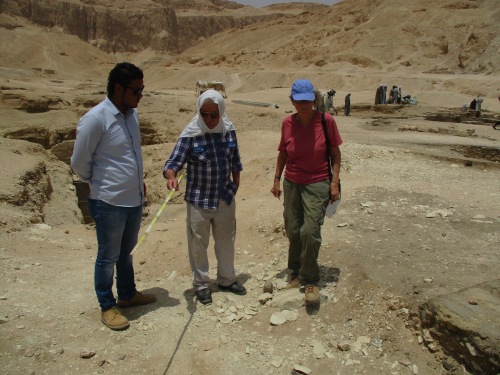
- Our assistant director, artist and photographer Katherine Blakeney is always ready to climb every mountain to record the architectural features of the tombs.
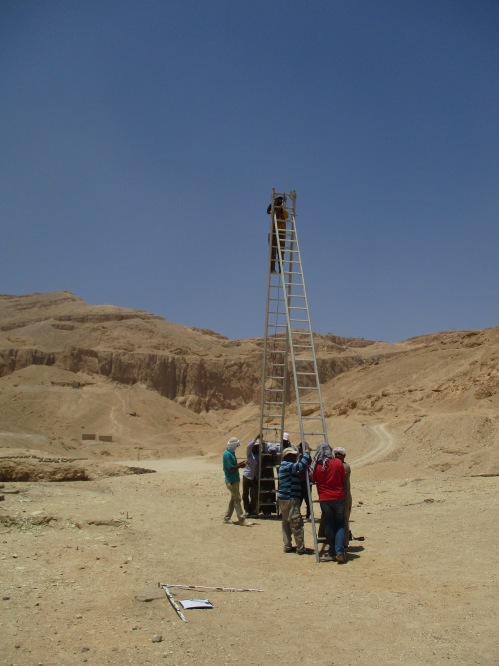
- New discoveries keep our excavation workmen, archaeologist Marion Brew and head of the registration department John Billman happy and busy.


- One of the best discoveries so far is a small fragment with the upper part of a G17 sign. The beautiful owl is carved in raised relief with precision and numerous details indicating feathers of different lengths and textures. Our conservator Mohamed Shebib with his photographic memory immediately remembered another fragment with the lower part of the bird found in 2015. The fragment is part of the decoration of the doorframe leading to the pillared hall in the tomb of Karabasken. What a great way to start the season!
More soon!
Bibliography
Graefe, Erhart "Report on the work on the fragments of the "Stundenritual" (Ritual of the Hours of the Day) in TT 223″. In Thebes in the First Millennium BC. , edited by Elena Pischikova, Julia Budka, Kenneth Griffin, 295-306. Newcastle upon Tyne: Cambridge Scholars Publishing 2014.
Graefe, Erhart. "Second report on work on the fragments of the Stundenritual (ritual of the hours of the day) in TT 223". In Tombs of the South Asasif Necropolis: New Discoveries and Research 2012-14, edited by Elena Pischikova, 91-95. Cairo; New York: The American University in Cairo Press, 2017, 91-95.
Griffin, Kenneth. "Toward a Better Understanding of the Ritual of the Hours of the Night (Stundenritual)" In Tombs of the South Asasif Necropolis: New Discoveries and Research 2012-14, edited by Elena Pischikova, 97-134. Cairo, New York: AUC Press, 2017.
Griffin, Kenneth. "A Preliminary Report on the Hours of the Night in the Tomb of Karakhamun (TT 223) ". In Thebes in the First Millennium BC: Art and Archaeology of the Kushite Period and Beyond, edited by Elena Pischikova, Julia Budka , Kenneth Griffin, 59-70. London: Golden House Publications, 2018.
Molinero Polo, Miguel. "The Textual Program of Karakhamun's First Pillared Hall." In Tombs of the South Asasif Necropolis: Thebes, Karakhamun (TT 223), and Karabasken (TT 391) in the Twenty-fifth Dynasty, edited by Elena Pischikova, 131-172. Cairo; New York: The American University in Cairo Press, 2014.
-- Sent from my Linux system.
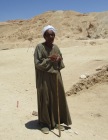

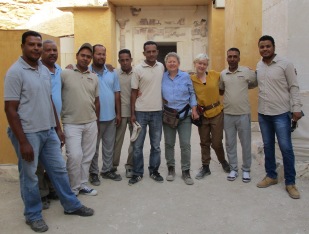







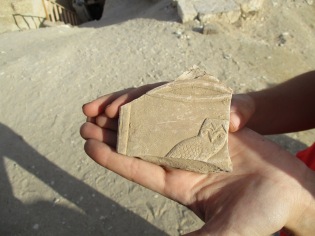


No comments:
Post a Comment